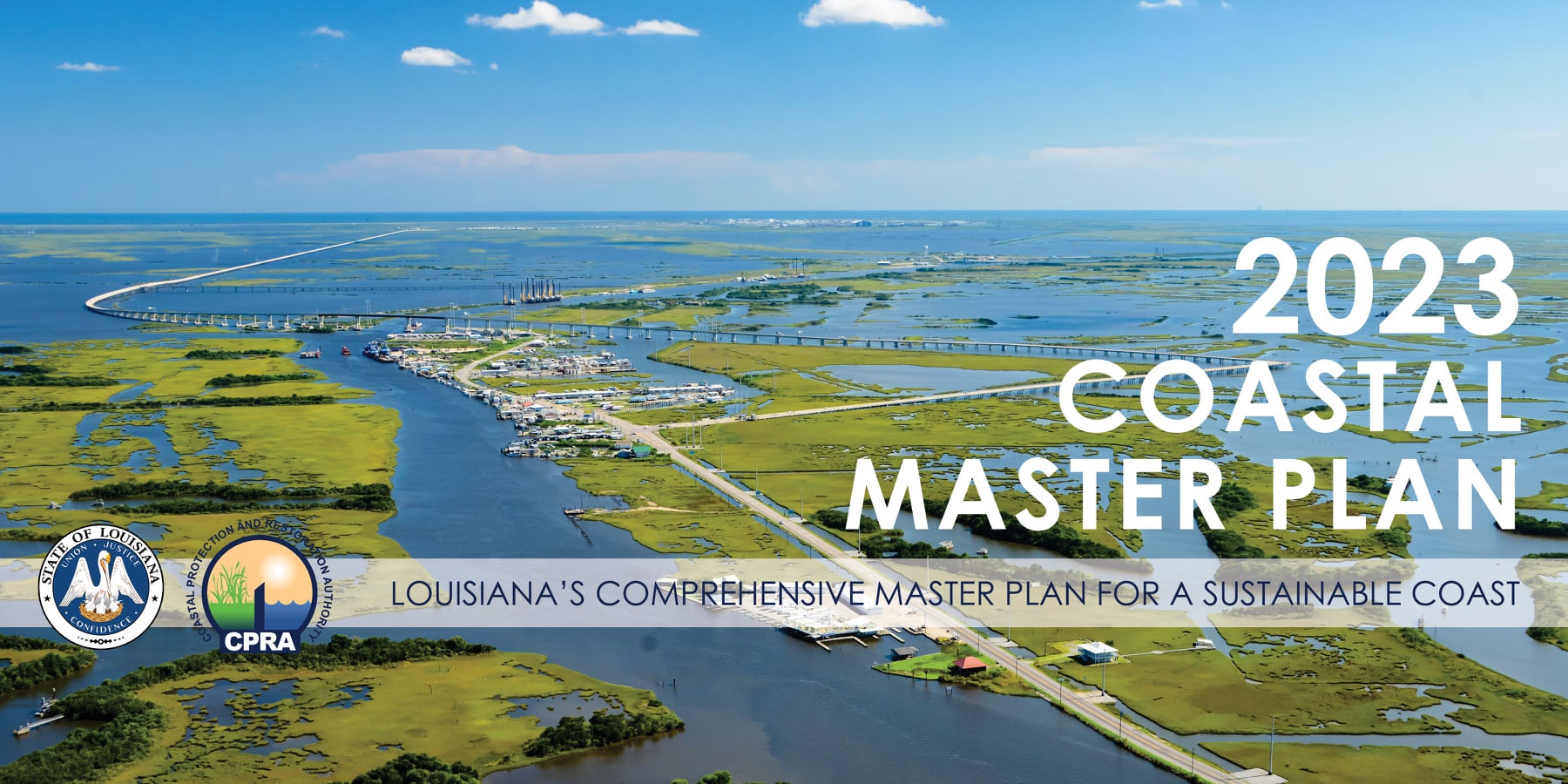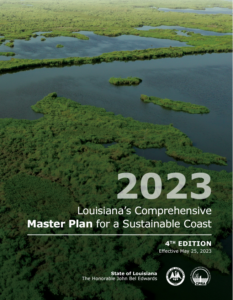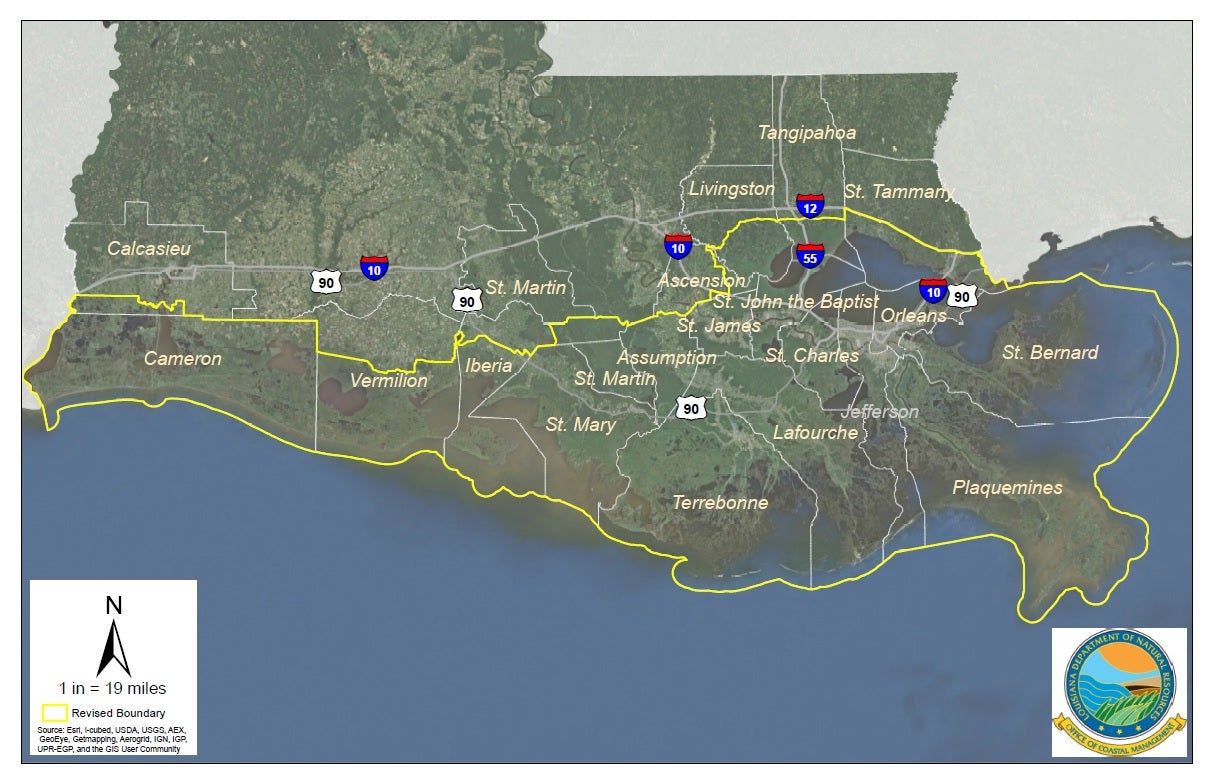Louisiana Coastal Master Plan
Following the devastating hurricanes of 2005, the Louisiana Legislature enacted several significant changes which altered the trajectory for Louisiana’s coast. Prior to 2005, coastal restoration and conservation fell under the Louisiana Department of Natural Resources, and hurricane protection/levees were a responsibility of the Louisiana Department of Transportation.
The legislature decided that protection and restoration could no longer happen in isolation, and the Coastal Protection and Restoration Authority (CPRA) was formed. Under this new state authority, the Louisiana Legislature also required that the CPRA develop a comprehensive plan for the protection and restoration of Louisiana’s coast to be created, so in 2007 the first Coastal Master Plan was released.

The 2007 plan was largely conceptual, utilizing previous studies such as the Louisiana Coastal Area Study, Coast 2020, and others. Since the plan must be updated regularly, the 2012 version delivered greater detail and introduced a modeling-based approach to project prioritization and selection thanks to a longer planning period and advances in technology and science. Since the changes introduced in the 2012 plan the state has put forward plans with a balance of 50% restoration projects and 50% protection projects. Each plan has proposed spending about $1 billion a year in current dollars for the next 50 years. The legislature deliberately chose fifty years and $50 billion as an aspirational but attainable goal, but the plan was formulated so that whatever funding was available, the most impactful projects within the budget would be prioritized.
The 2023 Coastal Master Plan is the fourth plan developed by the state to achieve its comprehensive coastal restoration and risk reduction goals. Drawing upon the achievements and progress made in earlier initiatives, the 2023 Coastal Master Plan seeks to enhance the process of project development and assessment, integrate cutting-edge scientific insights for refining tools and analyses, foster collaboration with federal, state, and local authorities, academic institutions, and non-governmental organizations, and ensure active involvement of stakeholders.
To address the challenges our changing coast faces, a collection of 77 projects aimed at restoration and risk mitigation has been identified in this new plan. This includes:
- 65 Restoration Projects
- 12 Structural Risk Reduction Projects
- $11B for Nonstructural Risk Reduction Projects
- $19B in Dredging Projects
Additionally, $2.5 billion is allocated to programmatic restoration efforts and small-scale strategies, e.g. bank stabilization and barrier island maintenance. Another $11.2 billion is allocated to nonstructural risk reduction activities, e.g. residential elevations, commercial floodproofing, and voluntary acquisition of properties.
The development of the 2023 plan saw greater community engagement thanks in part to the “Coastal Conversations” local meeting series hosted by CPRA, Restore the Mississippi River Delta and local partners. The Master Plan Data Viewer also enhanced engagement by visualizing various components of what makes the CMP one of the best and most innovative climate change adaptation plans on the planet. Through the viewer, the public can look at Louisiana’s land loss dating back from 1932 to the present and the projected land loss through 2073. Providing such extensive data aims to empower local leaders and residents by offering tailored information for their decision-making processes.
Geography: The official Louisiana Coastal Area defines the scope of where the CPRA’s projects and authority reside. The coastal area is slightly broader in scope than the federally and state-defined coastal area. The coastal area largely differs from the coastal zone by reaching northward to encompass the Old River Control Structure in Concordia Parish. This includes 20 coastal parishes from the Texas to Mississippi borders. Detailed “parish fact sheets” for each are available online from the 2023 Coastal Master Plan.
State Entities Involved: The Governor, the Coastal Protection and Restoration Authority, the CPRA Board, the Governor’s Office of Coastal Activities, GOCA Board, House and Senate Natural Resources and Transportation Committees, Full Legislature
Funding: There are 40+ different but generally small, restricted or shrinking sources of funding on the local, state, and federal levels. The exception is funding flowing from the legal settlement of the Deepwater Horizon Disaster. Seven to eight billion dollars from Deepwater Horizon will fund primarily restoration projects contained in the Coastal Master Plan through about 2031. Additionally, funding for the storm risk reduction projects in the plan has come through major pieces of federal legislation, but the mandatory cost share to these projects will depend upon as yet unidentified sources of revenue, which cannot include future Congressional appropriations. Securing a steady source of long-term revenue after 2031 will be critical to the plan’s success. Further, given the accelerating rate of sea-level rise ahead, money spent sooner will be more effective than money spent later. One billion dollars a year is not a limit on what could be spent effectively, but is the minimum investment we can make in our coast to expect a viable future
Points of Contact
MRD Contact
-
- Restore the Mississippi River Delta contact, Campaign Director, Simone Maloz: smaloz@mississippiriverdelta.org

